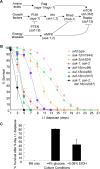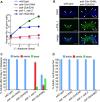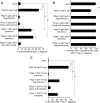C. elegans AMPKs promote survival and arrest germline development during nutrient stress
- PMID: 23213370
- PMCID: PMC3507181
- DOI: 10.1242/bio.2012836
C. elegans AMPKs promote survival and arrest germline development during nutrient stress
Abstract
Mechanisms controlling development, growth, and metabolism are coordinated in response to changes in environmental conditions, enhancing the likelihood of survival to reproductive maturity. Much remains to be learned about the molecular basis underlying environmental influences on these processes. C. elegans larvae enter a developmentally dormant state called L1 diapause when hatched into nutrient-poor conditions. The nematode pten homologue daf-18 is essential for maintenance of survival and germline stem cell quiescence during this period (Fukuyama et al., 2006; Sigmond et al., 2008), but the details of the signaling network(s) in which it functions remain to be elucidated. Here, we report that animals lacking both aak-1 and aak-2, which encode the two catalytic α subunits of AMP-activated protein kinase (AMPK), show reduced viability and failure to maintain mitotic quiescence in germline stem cells during L1 diapause. Furthermore, failure to arrest germline proliferation has a long term consequence; aak double mutants that have experienced L1 diapause develop into sterile adults when returned to food, whereas their continuously fed siblings are fertile. Both aak and daf-18 appear to maintain germline quiescence by inhibiting activity of the common downstream target, TORC1 (TOR Complex 1). In contrast, rescue of the lethality phenotype indicates that aak-2 acts not only in the intestine, as does daf-18, but also in neurons, likely promoting survival by preventing energy deprivation during L1 diapause. These results not only provide evidence that AMPK contributes to survival during L1 diapause in a manner distinct from that by which it controls dauer diapause, but they also suggest that AMPK suppresses TORC1 activity to maintain stem cell quiescence.
Keywords: AMPK; Diapause; Stem cell.
Conflict of interest statement
Figures




Similar articles
-
Cell Non-autonomous Function of daf-18/PTEN in the Somatic Gonad Coordinates Somatic Gonad and Germline Development in C. elegans Dauer Larvae.Curr Biol. 2019 Mar 18;29(6):1064-1072.e8. doi: 10.1016/j.cub.2019.01.076. Epub 2019 Feb 28. Curr Biol. 2019. PMID: 30827916 Free PMC article.
-
Developmental plasticity and the response to nutrient stress in Caenorhabditis elegans.Dev Biol. 2021 Jul;475:265-276. doi: 10.1016/j.ydbio.2021.01.015. Epub 2021 Feb 4. Dev Biol. 2021. PMID: 33549550 Review.
-
C. elegans DAF-18/PTEN mediates nutrient-dependent arrest of cell cycle and growth in the germline.Curr Biol. 2006 Apr 18;16(8):773-9. doi: 10.1016/j.cub.2006.02.073. Curr Biol. 2006. PMID: 16631584
-
Germline stem cell integrity and quiescence are controlled by an AMPK-dependent neuronal trafficking pathway.PLoS Genet. 2023 Apr 14;19(4):e1010716. doi: 10.1371/journal.pgen.1010716. eCollection 2023 Apr. PLoS Genet. 2023. PMID: 37058536 Free PMC article.
-
AMPK Regulates Developmental Plasticity through an Endogenous Small RNA Pathway in Caenorhabditis elegans.Int J Mol Sci. 2020 Mar 24;21(6):2238. doi: 10.3390/ijms21062238. Int J Mol Sci. 2020. PMID: 32213851 Free PMC article. Review.
Cited by
-
C. elegans monitor energy status via the AMPK pathway to trigger innate immune responses against bacterial pathogens.Commun Biol. 2022 Jun 30;5(1):643. doi: 10.1038/s42003-022-03589-1. Commun Biol. 2022. PMID: 35773333 Free PMC article.
-
Cell-cycle quiescence maintains Caenorhabditis elegans germline stem cells independent of GLP-1/Notch.Elife. 2015 Nov 9;4:e10832. doi: 10.7554/eLife.10832. Elife. 2015. PMID: 26551561 Free PMC article.
-
Loss of FIC-1-mediated AMPylation activates the UPRER and upregulates cytosolic HSP70 chaperones to suppress polyglutamine toxicity.PLoS Genet. 2025 Jun 13;21(6):e1011723. doi: 10.1371/journal.pgen.1011723. eCollection 2025 Jun. PLoS Genet. 2025. PMID: 40512832 Free PMC article.
-
Loss of a neural AMP-activated kinase mimics the effects of elevated serotonin on fat, movement, and hormonal secretions.PLoS Genet. 2014 Jun 12;10(6):e1004394. doi: 10.1371/journal.pgen.1004394. eCollection 2014 Jun. PLoS Genet. 2014. PMID: 24921650 Free PMC article.
-
Regulation of reproduction and longevity by nutrient-sensing pathways.J Cell Biol. 2018 Jan 2;217(1):93-106. doi: 10.1083/jcb.201707168. Epub 2017 Oct 26. J Cell Biol. 2018. PMID: 29074705 Free PMC article. Review.
References
LinkOut - more resources
Full Text Sources
Research Materials
Miscellaneous

